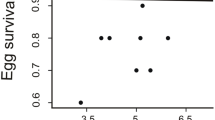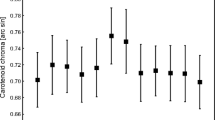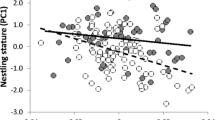Abstract
When allocating investment among offspring, parents might maximize their fitness by biasing investment toward offspring with the best direct fitness prospects. The observed preferences of avian parents for carotenoid-rich mouth colors that advertise good condition has been interpreted as support for this hypothesis. However, because these condition-dependent visual signals might also make offspring more visually conspicuous, active parental preferences for carotenoid-rich traits are difficult to distinguish from passive responses to differences in detectability among offspring. Here, we used a visual model to examine how mouth colors influence the visual conspicuousness of nestling house sparrows (Passer domesticus) to parents under a suite of realistic ambient light conditions. We found little evidence that mouths rich in carotenoids provided more conspicuous targets to parents than mouths poor in carotenoids. While other features of mouth color may have evolved to increase conspicuousness, our results suggest that carotenoid-based coloration is not a product of detectability pressures and rather may serve as a signal of nestling quality.

Similar content being viewed by others
References
Abramoff MD, Magelhaes PJ, Ram SJ (2004) Image processing with ImageJ. Biophoton Int 11:36–42
Anderson TR (2006) Biology of the ubiquitous house sparrow: from genes to populations. Oxford University Press, New York
Andersson S (2000) Efficacy and content in avian colour signals. In: Espmark Y, Amundsen T, Rosenqvist G (eds) Animal signals: signalling and signal design in animal communication. Tapir Academic, Trondheim, pp 47–60
Andersson S, Prager M (2006) Quantifying colors. In: Hill GE, McGraw KJ (eds) Bird coloration volume 1: mechanisms and measurements. Harvard University Press, Cambridge, pp 41–89
Arnqvist G (2006) Sensory exploitation and sexual conflict. Phil Trans R Soc Lond B 361:375–386
Avilés JM, Peréz-Contreras T, Navarro C, Soler JJ (2008) Dark nests and conspicuousness in color patterns of nestlings of altricial birds. Am Nat 171:327–338
Bize P, Piault R, Moureau B, Heeb P (2006) A UV signal of offspring condition mediates context-dependent parental favouritism. Proc R Soc Lond B 273:2063–2068
Chen D, Goldsmith TH (1986) Four spectral classes of cones in the retinas of birds. J Comp Physiol A 159:473–479. doi:10.1007/BF00604167
Cummings ME (2007) Sensory trade-offs predict signal divergence in surfperch. Evolution 61:530–545
de Ayala RM, Saino N, Møller AP, Anselmi C (2007) Mouth coloration of nestlings covaries with offspring quality and influences parental feeding behavior. Behav Ecol 18:526–534
Dugas MB (2009) House sparrow (Passer domesticus) parents preferentially feed nestlings with mouth colours that appear carotenoid-rich. Anim Behav 78:767–772
Endler JA (1990) On the measurement and classification of color in studies of animal color patterns. Biol J Linnaean Soc 41:315–352
Endler JA (1993a) The color of light in forests and its implications. Ecol Monogr 63:1–27
Endler JA (1993b) Some general comments on the evolution and design of animal communication systems. Phil Trans R Soc Lond B 340:215–225
Ewen JG, Thorogood R, Karadas F, Cassey P (2008) Condition dependence of nestling mouth colour and the effect of supplementing carotenoids on parental behaviour in the hihi (Notiomystis cincta). Oecologia 157:361–368
Ficken MS (1965) Mouth color of nestling passerines and its use in taxonomy. Wilson Bull 77:71–75
Fox HM, Vevers G (1960) The nature of animal colors. The MacMillan Company, New York
Galván I, Ama L, Sanz JJ (2008) Ultraviolet-blue reflectance of some nestling plumage patches mediates parental favouritism in great tits Parus major. J Avian Biol 39:277–282
Godfray HCJ (1991) Signalling of need by offspring to their parents. Nature 35:328–330
Godfray HCJ (1995) Signalling of need between parents and young: parent-offspring conflict and sibling rivalry. Am Nat 146:1–24
Gomez D, Théry M (2007) Simultaneous crypsis and conspicuousness in color patterns: comparative analysis of a neotropical rainforest bird community. Am Nat 169:S42–S61
Götmark F, Ahlström M (1997) Parental preference for red mouths of chicks in a songbird. Proc R Soc Lond B 264:959–962
Ham AD, Osorio D (2007) Colour preferences and colour vision in poultry chicks. Proc R Soc Lond B 274:1941–1948. doi:10.1098/rspb.2007.0538
Heeb P, Schwander T, Faoro S (2003) Nestling detectability affects parental feeding preferences in a cavity-nesting bird. Anim Behav 66:637–642
Hill GE (1996) Redness as a measure of the production costs of ornamental traits. Ethol Ecol Evol 8:157–175
Hill GE (2002) Red bird in a brown bag: the function and evolution of colorful plumage in the house finch. Oxford University Press, USA
Houde AE (1997) Sex, color and mate choice in guppies. Princeton University Press, Princeton
Hunt S, Kilner RM, Langmore NE, Bennett ATD (2003) Conspicuous, ultraviolet-rich mouth colours in begging chicks. Proc R Soc Lond B 270:S25–S28
Ingram C (1920) A contribution to the study of nestling birds. Ibis 2:856–880
Jones CD, Osorio D (2004) Discrimination of oriented visual textures by poultry chicks. Vision Res 44:83–89
Jourdie V, Moureau B, Bennett ATD, Heeb P (2004) Ultraviolet reflectance by the skin of nestlings. Nature 431:262
Kacelnik A, Cotton PA, Stirling L, Wright J (1995) Food allocation among nestling starlings: sibling competition and the scope of parental choice. Proc R Soc Lond B 259:259–263
Kilner RM (1995) When do canary parents respond to nestling signals of need? Proc R Soc Lond B 260:343–348
Kilner R (1997) Mouth color is a reliable signal of need in begging canary nestlings. Proc R Soc Lond B 264:964–968
Kilner RM (1999) Family conflicts and the evolution of nestling mouth colour. Behaviour 136:779–804
Kilner R, Davies NB (1998) Nestling mouth colour: ecological correlates of a begging signal. Anim Behav 56:705–712
Loiseau C, Fellous S, Haussy C, Chastel O, Sorci G (2008) Condition-dependent effects of corticosterone on a carotenoid-based begging signal in house sparrows. Horm Behav 53:266–273
Lyon BE, Eadie JM, Hamilton LD (1994) Parental favoritism selects for ornamental plumage in American coot chicks. Nature 37:240–243
Macías García C, Ramirez E (2005) Evidence that sensory traps can evolve into honest signals. Nature 434:501–505
Marchetti K (1993) Dark habitats and bright birds illustrate the role of the environment in species divergence. Science 362:149–152
Mondloch CJ (1995) Chick hunger and begging affect parental allocation of feedings in pigeons. Anim Behav 49:601–613
Montgomerie R (2006) Analyzing colors. In: Hill GE, McGraw KJ (eds) Bird coloration volume 1: mechanisms and measurements. Harvard University Press, Cambridge, pp 90–147
Osorio D, Miklosi A, Gonda Z (1999) Visual ecology and perception of coloration patterns by domestic chicks. Evol Ecol 13:673–689
Parker GA, Royle NJ, Hartley IR (2002) Begging scrambles with unequal chicks: interactions between need and competitive ability. Ecol Lett 5:206–215
Price K, Ydenberg R (1995) Begging and provisioning in broods of asynchronously hatched yellow-headed blackbird nestlings. Behav Ecol Sociobiol 37:201–208
Reynolds SJ, Martin GR, Cassey P (2009) Is sexual selection blurring the functional significance of eggshell coloration hypotheses? Anim Behav 78:209–215
Royle NJ, Hartley IR, Parker GA (2002) Begging for control: when are offspring solicitation behaviours honest? Trends Ecol Evol 17:434–440
Ryan MJ, Keddy-Hector A (1992) Directional patterns of female mate choice and the role of sensory biases. Am Nat 139:S4–S35
Saino N, Ninni P, Calza S, Martinelli R, de Bernardi F, Møller AP (2000) Better red than dead: carotenoids-based mouth colouration reveals infection in barn swallow nestlings. Proc R Soc Lond B 26:57–61
Saino N, Ambrosini R, Martinelli R, Ninni P, Møller AP (2003) Gape coloration reliably reflects immunocompetence of barn swallow (Hirundo rustica) nestlings. Behav Ecol 14:16–22
Saks L, McGraw KJ, Horak P (2003) How feather colour reflects its carotenoid content. Funct Ecol 17:555–561
Schaefer HM, Levey DJ, Schaefer V, Avery ML (2006) The role of chromatic and achromatic signals for fruit detection by birds. Behav Ecol 17:784–789. doi:10.1093/beheco/arl011
Schwagemeyer PL, Mock DW (2008) Parental provisioning and offspring fitness: size matters. Anim Behav 75:291–298
Schwagmeyer PL, Mock DW (1997) How to minimize sample sizes while preserving statistical power. Anim Behav 54:470–474
Schwagmeyer PL, Mock DW, Parker GA (2002) Biparental care in house sparrows: negotiation or sealed bid? Behav Ecol 13:713–721
Shawkey MD, Hill GE (2005) Carotenoids need structural colors to shine. Biol Lett 1:121–124
Smith HG, Montgomerie R (1991) Nestling American robins compete with siblings by begging. Behav Ecol Sociobiol 29:307–312
Stuart-Fox D, Moussalli A, Whiting MJ (2008) Natural selection on social signals: signal efficacy and the evolution of chameleon display coloration. Am Nat 170:916–930. doi:10.1086/522835
Thorogood R, Kilner RM, Karadas F, Ewen JG (2008) Spectral mouth colour of nestlings changes with carotenoid availability. Funct Ecol 22:1044–1051. doi:10.1111/j.1365-2435.2008.01455.x
Trivers RL (1974) Parent-offspring conflict. Am Zool 14:249–264
Wong BBM, Rosenthal GG (2006) Female disdain for swords in a swordtail fish. Am Nat 167:136–140
Acknowledgments
We thank Jennifer Place for assistance with field work and Doug Mock and P.L. Schwagmeyer for generously providing access to birds. The Institutional Animal Care and Use Committee of the University of Oklahoma approved all protocols (R06-012). Research was funded by a George Miksch Sutton Scholarship in Ornithology to MD, who was also supported by an Alumni Fellowship and Adams Scholarship in Zoology from the University of Oklahoma. Doug Mock, P.L. Schwagmeyer, Rosemary Knapp, Ingo Schlupp, Anne Magurran, Marty Leonard, Tatiana Czeschlik, several anonymous reviewers, and the ZEEB Graduate Review all provided helpful critiques of manuscript drafts.
Author information
Authors and Affiliations
Corresponding author
Additional information
Communicated by M. Leonard
Electronic supplementary material
Below is the link to the electronic supplementary material.
Online supplementary material 1
Loadings of contrast values under each ambient light condition on the principal components representing achromatic and chromatic (located in individual tabs) contrast of the flange against the palate and nesting material. (XLS 24 kb)
Rights and permissions
About this article
Cite this article
Dugas, M.B., Rosenthal, G.G. Carotenoid-rich mouth colors influence the conspicuousness of nestling birds. Behav Ecol Sociobiol 64, 455–462 (2010). https://doi.org/10.1007/s00265-009-0861-z
Received:
Revised:
Accepted:
Published:
Issue Date:
DOI: https://doi.org/10.1007/s00265-009-0861-z




